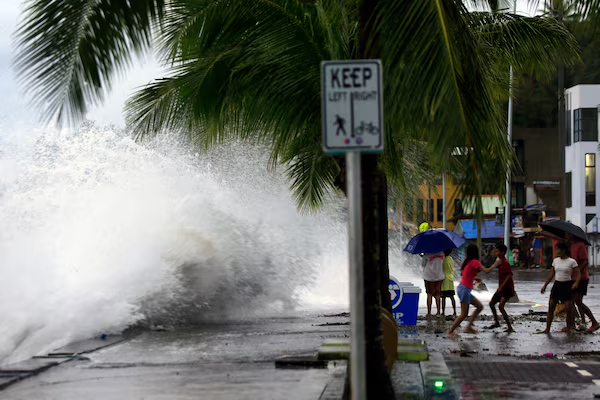Philippines Braces for Super Typhoon Man-Yi: Warnings, Evacuations, and Preparedness Efforts
The Philippines is on high alert as Super Typhoon Man-Yi intensifies on its path toward Luzon, the country’s largest and most populous island. With maximum sustained winds of 195 kph (121 mph) and gusts reaching 240 kph, the typhoon has prompted Philippine authorities to issue urgent evacuation orders, particularly in low-lying and coastal areas.
This marks the sixth tropical cyclone to strike the country within a month, placing already vulnerable regions at greater risk of severe flooding, landslides, and storm surges.
The Philippine Atmospheric, Geophysical and Astronomical Services Administration (PAGASA) has raised its storm alert to the highest level for the provinces of Catanduanes and Camarines Sur in the central Bicol region. As of 5 p.m. local time, the typhoon was located approximately 120 kilometers east of Catanduanes and is expected to make landfall late Saturday night or early Sunday morning.
PAGASA has warned that the storm poses a “potentially catastrophic and life-threatening situation” for the Bicol region. Residents have been urged to brace for heavy rainfall, severe winds, and storm surges that could reach up to three meters (10 feet).

Authorities have launched extensive evacuation efforts, with more than 500,000 people already relocated from six provinces in the Bicol region. This number is expected to increase as local officials work tirelessly to ensure the safety of those in the storm’s projected path.
Ariel Nepomuceno, head of the Office of Civil Defense, emphasized the importance of immediate evacuation, particularly for those in landslide-prone areas. “It is more dangerous now for those in landslide-prone areas because the ground has been saturated by the consecutive typhoons,” he said, underscoring the compounding effects of recent storms.
READ ALSO: G7 Blames Russia for Blocking Peace in Ukraine
To support disaster response efforts, nearly 40,000 uniformed personnel are on standby for search, rescue, and relief operations. Over 2,000 vehicles, including navy vessels, have been prepared for deployment. Nepomuceno expressed hope for “zero casualties” through proactive measures and coordination.
The impact of Typhoon Man-Yi is expected to extend beyond the Bicol region. PAGASA forecasts that the Metro Manila capital region will experience heavy to intense rainfall as early as Sunday. Residents in surrounding areas have been advised to prepare for possible flooding and disruptions.
In the eastern Visayas region, the typhoon has already caused the cancellation of numerous flights, adding to the logistical challenges posed by the storm.
The Philippines has faced an unprecedented onslaught of tropical cyclones this year. October alone saw Tropical Storm Trami and Typhoon Kong-rey unleash floods and landslides that claimed 162 lives, with 22 individuals still missing. The Japan Meteorological Agency noted that this month marked the first time in recorded history that four storms were active simultaneously in the western Pacific Ocean.
The frequency and intensity of these storms have left many areas in a fragile state, with saturated ground increasing the likelihood of landslides.
The Philippines, located along the Pacific Ring of Fire and the typhoon belt, is no stranger to severe weather events. On average, the country is struck by 20 tropical storms annually, bringing heavy rains, strong winds, and deadly landslides.

Super Typhoon Man-Yi serves as a grim reminder of the challenges posed by climate change and the urgent need for disaster preparedness. With thousands of personnel mobilized and evacuation efforts in full swing, the Philippine government aims to minimize casualties and provide swift relief to affected communities.
As the storm bears down on Luzon, the resilience and unity of the Filipino people will once again be put to the test. Authorities urge residents to stay informed, comply with evacuation orders, and prioritize safety as the nation confronts yet another powerful storm.
Discover more from Cine critique
Subscribe to get the latest posts sent to your email.

